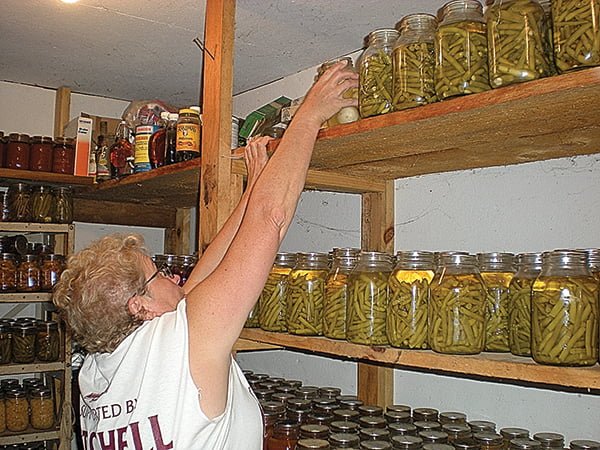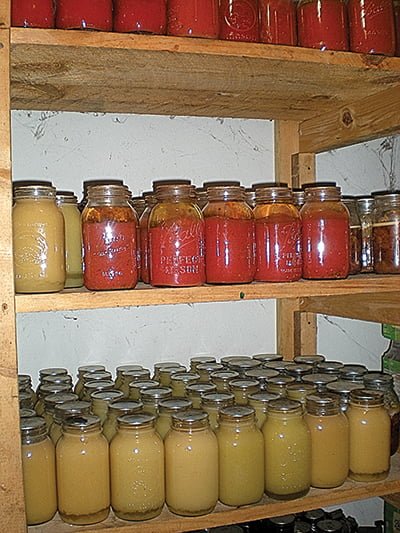
Suzanne Stewart
Staff Writer
Preservation of food through canning has been a vital part of life in America since the 1800s. Families grew modest gardens and canned what they could to ensure they had food all year long.
The tradition of canning has been a part of Dunmore resident Ruth Bland’s life since she was a child. Growing up in western Pennsylvania, Bland was taught the value of preservation by her parents – her mother, who grew up on a farm, and her father, who grew up with a garden.
“My mother grew up one of twelve – actually thirteen, one died at birth – on a dairy farm outside of Pittsburgh in western Pennsylvania,” Bland said. “They butchered their own beef. They butchered their own hogs, their own chickens. They had boiler chickens. They had their own dairy just for them, and then they also sold milk to the Shrums Dairy.”
When Bland’s parents were married, they continued to do as they had learned and grew a garden and preserved everything.
“They always had a big garden and Mom always canned,” Bland said. “Dad had a garden, and we lived on about three-quarters of an acre of land, and his father had lived there. They made the postage stamp gardens. So [Dad] had plots, and he had walkways between the postage stamps. A postage stamp garden is – they’re side-by-side and you put tomatoes in this one and onions in that one.”
It was very seldom Bland had store-bought food when she was growing up.

“We never bought a store [made] pie even with a bakery down the street,” she said. “Mom always made the pie crust and made the pies. Never [store bought] fruit on the inside. It was always fresh or her canned fruit. That’s always how we ate.”
Bland carries on the tradition with her husband, Steve, and their family. At their residence in Dunmore, the Blands have three separate gardens, apple trees, grapevines and beehives, all of which are harvested and preserved if not eaten fresh.
“It really saves on your grocery bills,” Bland said. “I don’t buy green beans. I don’t buy corn. I have peas frozen. I have broccoli frozen. I have cauliflower frozen. The only thing that I really buy at the store – I’m starting to buy meat now because we didn’t butcher a beef last year.”
If the food in the freezer sounds impressive, then the cellar will truly amaze.
Although it is small, Bland’s cellar is stocked full of jars of applesauce, ramps, tomato sauce, tomatoes, potatoes, green beans, peaches and even deer meat and bear meat.
There is even a crock of sauerkraut fermenting in there.
While she uses the tradition of canning that has been around for years, Bland has added a few new techniques to preserve food, including a vacuum sealer and dehydrator.
“I do a lot of dehydrating,” she said. “I did cherry tomatoes in the dehydrator. They turned out beautiful.”
Along with keeping tradition alive and saving money, preserving food leads to a much healthier lifestyle – the effects of which Bland has seen herself.
“It is very good exercise,” she said. “In the summer is when I lose the most weight because I’m in the garden. I’m mowing, I’m hoeing, doing what you need to do to keep the garden going, and it is a healthy lifestyle. I only put one teaspoon of salt in the green beans when I can. That’s it.”
The healthy choices have spread out into other culinary adventures, including less sugar and white flour.
“I’ve been moving away from the white sugar and using only honey,” Bland said. “One cup of sugar equals one cup of honey for the sweetener. If I can get my own honey, I can get rid of sugar. I’ve started putting honey in my coffee. I’m feeling better since I got rid of sugar in my coffee.
“When I bake bread, I put honey in the bread, too,” she added. “I bake with whole wheat flour instead of white flour. The best thing I ever got for Christmas is a KitchenAid[mixer]. I can make anything in that now.”
Just like her parents, Bland is teaching her children the importance of raising and preserving your own food. Two of the three, Shawn and Chloe, help cultivate the gardens. Emily used to help, but lives too far away now.
What it all boils down to is having a good lifestyle and enjoying the fruits of your labor.
“It’s so much fun to see it when it’s all down and you’re pulling [the jars] out of the canner and you’re hearing them pop,” Bland said. “The other thing is, it tastes so much better than grocery store stuff. You know what’s in it.”


